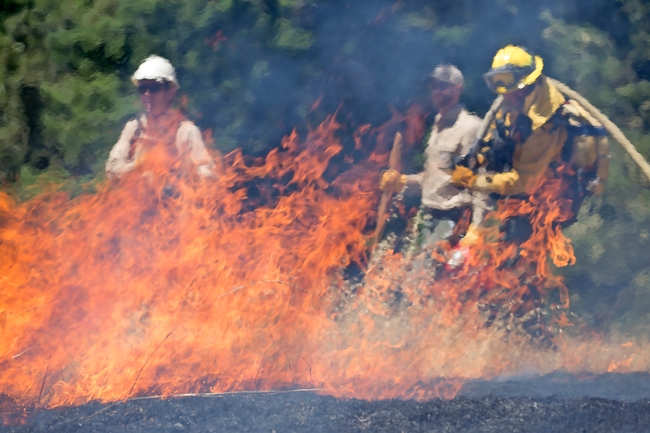Eight (of many) ways UC ANR benefits the California economy
UC ANR works to benefit the California economy by improving agricultural efficiencies, mitigating risk, providing trusted information to inform policy, combating pests and diseases, advancing agriculture technologies and training the next generation of leaders. Additionally, UC ANR improves community health and well-being through nutrition education, saving millions in healthcare costs and reducing monthly grocery bills. UC ANR's work is supported by more than 26,000 volunteers who provide donated service worth $71 million annually.
Nutrition
UC ANR's Expanded Food and Nutrition Education Program (EFNEP) helps limited-resource participants develop food buying and budgeting skills. Graduates save an average of $58.10 in monthly food costs, which collectively saved EFNEP families $1,532,445 last year.
Small farms
UC Cooperative Extension (UCCE) research supports small farmers through evaluation of crops and providing business training, among other activities. For example, UCCE is evaluating techniques to optimize coffee production in San Diego County. Specialty coffees could be valued at $50,000 per acre compared to $10,000 to $20,000 per acre for citrus or avocadoes. Small-scale prospective coffee growers learned it is possible to grow their own nursery plants, reducing startup costs, and are trialing coffee using plant starts provided by UCCE. Another example is in California's Sierra Foothills, home to a diversity of small farms with a wide variety of crops. UC ANR provides on-farm workshops focused on building producers' skills in economic and market analysis, risk management and business planning. UCCE advisors and specialists have also provided COVID-19-related information in Chinese and Spanish for immigrant farmers, and helped Asian and Latino small farmers complete English-language disaster aid applications.
Crop protection
A plant pathology laboratory at the UC West Side Research and Extension Center rapidly diagnosed late blight in tomatoes in Fresno County, and UCCE provided outreach and education on an effective treatment. The late blight was treated and did not become an issue; if it had gone untreated, 155 acres of tomatoes worth $700,000 could have been ruined.
We work with California's grape industry to meet sustainable production goals and improve adaptability to a changing climate, through research and extension in plant material selection, pest and disease management, irrigation and natural resource stewardship. Our scientists are active in invasive species response and played a pivotal role in the eradication of the European grapevine moth from our state.
Crop safety
During the devastating 2018 fire season, growers were unsure if forage crops covered in ash were safe for animals to eat. A collaborative effort with a veterinary toxicologist to collect and analyze samples determined there was no contamination due to the fires. It was important to verify the safety and quality of the crops as toxic impacts could have been financially devastating to the $6.37 billion forage crop industry.
Analysts estimate wildfire damage to California winegrapes amounts to as much as $3.7 billion annually. Growers and wine buyers rely on UC ANR research on the effects of smoke and ash on grapes to make informed decisions and protect their livelihoods.
Pest management
Adoption of UC Integrated Pest Management practices in California provides an estimated annual benefit of $323 million to $500.5 million for agriculture alone. For example, pest control advisers in the San Joaquin Valley participated in a UCCE project using mating disruption to reduce navel orangeworm infestations. This “green” technology increased the almond crop value by more than $250 per acre, which is more than twice the cost of applying the technique. Mating disruption technology is available to use in all nut crops, which is about 2.2 million acres. If just 25% of farmers from California's $6 billion almond industry adopted these green technologies to fend off the navel orangeworm, it could save growers up to $10 million per year.
Irrigation
UC ANR Cooperative Extension research and outreach have been instrumental in the development of drip irrigation, which is now used on approximately 40% of irrigated cropland in California. A recent study valued the additional revenue attributable to this research at between $78 million and $283 million per year.
Crop varieties
Approximately 95% of California's rice acreage is planted with varieties that have been evaluated in UCCE variety trials, indicating very high levels of adoption of improved varieties. These varieties have allowed growers to maintain high productivity.
UC ANR works to bring new pathogen-tested citrus varieties to California growers. In 2019, nine varieties that completed therapy and testing were introduced by large citrus producers in the state. Thousands of farm and agricultural industry supporting jobs could be maintained or created in the next few years as these and additional new varieties are propagated, grown in the field, commercially grown, and moved to market for consumers.
Wildfire
California's wildfires have consumed increasing resources every year due to climate change and more people moving to fire-prone areas. UC Fire Advisors routinely host prescribed fire workshops throughout California, helping private landowners understand the benefits and techniques for using prescribed burns. UC Cooperative Extension Advisors in Humboldt County spurred creation of the first prescribed burn association in the West, which proliferated to six other counties across the state.
UC advisors have developed new technologies to help prevent wildfires. These include Evalutree, an app-based assessment tool designed to expedite and simplify tree surveys by PG&E, and Match.Graze, a web-based platform that connects private landowners with livestock owners that offer grazing services to reduce fire fuels.
Additionally, UCCE researchers released a free 20-page publication, “How to Harden Homes against Wildfire” (http://ucanr.edu/HomeRetrofitGuide).

2017 prescribed burn training in Humboldt County
